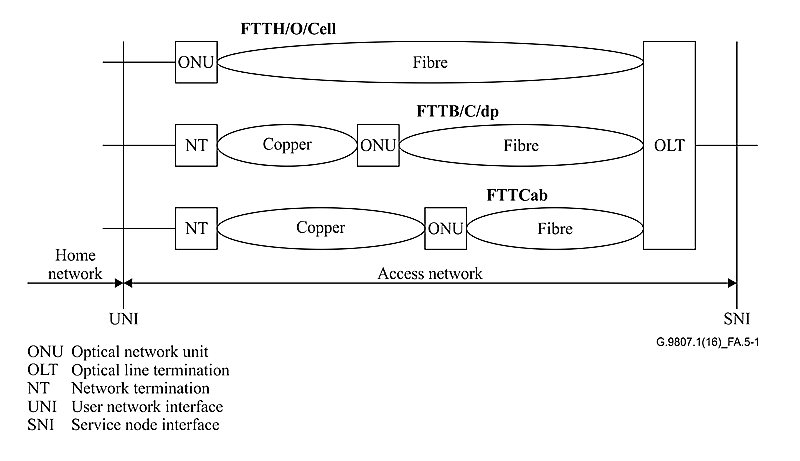Blog, Optical Networking
What Is XGS-PON: A Beginner’s Guide
With the current surge in data traffic and the increasing number of people working from home, video conferencing, streaming media, and other applications are increasingly used. Therefore, network reliability, bandwidth capacity, and security have become pressing issues for broadband service providers (BSP). In response, BSP is deploying a 10G symmetric passive optical network. So, what is XGS-PON? What are the advantages?
Table of contents
What is XGS-PON?
XGS-PON is a 10 Gbps symmetric passive optical network (X=10, S=symmetric). Optical fiber’s greater transmission capacity and speed deliver upstream and downstream (symmetric) speeds of up to 10 Gbit/s (gigabits per second) on the road to connecting users in the last mile.
This means that users can transfer and download large-capacity files equally fast over long distances, allowing them to experience fantastic performance when playing cloud games or watching 4K videos.
Evolution of GPON Technology
GPON (Gigabit Passive Optical Network) is an access technology for passive optical networks (PON) based on the ITU-T G.984.x standard. GPON provides 2.5 Gbps downstream bandwidth and 1.25 Gbps upstream bandwidth. The development of GPON has contributed to the development and popularization of FTTH. With the growing demand for higher bandwidth, new generation PON technologies such as 10G passive Optical Networks and 10G symmetric Passive optical Networks have emerged.
XG-PON (10 Gb Passive Optical Network) was launched in 2010, providing 10 Gbps downstream bandwidth and 2.5 Gbps upstream bandwidth.
XGS-PON is a further development of GPON technology. In 2016, it replaced the 10G Passive Optical Network, which operated synchronously. It is designed to provide symmetrical uplink and downlink bandwidths, with uplink and downlink data rates up to 10 Gbps.
XGS-PON Structure and Components
In a 10Gbps symmetric passive optical network, there is an optical line terminal (OLT) at the service provider’s end, multiple optical network units (ONUs) or optical network terminals (ONTs) near the end user, a splitter (SPL) in the middle to manage the distribution of the fiber network, and the ODN acts as the optical transmission medium between the ONT and the OLT.
1. XGS-PON OLT
The OLT (Optical Line Termination) is the starting point of the passive optical network and connects to the core switch via an Ethernet cable. Its primary function is to convert, frame, and transmit signals for the PON network and coordinate the multiplexing of the Optical Network Terminals to share uplink transmissions.
When operating at the basic wavelength set, the XGS-PON OLT port supports dual line rates (nominal 2.5 Gbit/s and 10 Gbit/s) in the uplink direction. This makes it compatible with 10 Gb Symmetric Optical Network ONUs coexisting on the same ODN as the 10 Gb Passive Optical Network ONU.
2. XGS-PON ONT
The ONT (Optical Network Terminal) converts the optical signals transmitted over the optical fiber into electrical signals, which are then sent to individual subscribers. The end-user device can also be called an Optical Network Unit (ONU). ONT is essentially the same as ONU, which is ITU-T terminology, while OLT is IEEE terminology and belongs to a different body of standards.
3. Optical Splitters
These passive devices manage the transmission of optical signals. For example, a 1:16 splitter divides an input signal into 16 output signals, allowing a single OLT port to serve multiple ONTs, which optimizes the use of fiber optic resources and provides a network for multiple users.

4. Optical Distribution Network (ODN)
The ODN is the necessary route for XGS-PON data transmission. There are two directions for optical transmission in the ODN: the downstream direction of signal transmission from the OLT to the ONU and the upstream direction of signal transmission from the ONU to the OLT.
Advantages of XGS-PON
1. High Bandwidth Features
10 Gbps upload and download speeds are at the heart of XGS-PON’s technology. This level of performance allows users to transmit 4K and 8K HD video streams, participate in multiplayer HD video conferences, and engage in multiplayer games online.
2. Low-cost Investment, Long-term Value
XGS-PON can coexist with XG-PON and GPON in the same network, so operators and subscribers can upgrade their networks without changing hardware. Today, this type of network is at the peak of deployment.
3. Energy Efficiency
With global warming, energy is now a significant concern. Energy-efficient technologies have become a key focus for operators, reducing operating costs and meeting national regulatory requirements. XGS-PON offers downlink speeds up to four times faster than GPON but consumes only 1.7 times more power.
4. Security
XGS-PON inherits the advantages of previous technologies regarding data transmission security and network reliability. Fiber optic transmission is inherently more secure, providing higher bandwidth while maintaining high data security and network reliability requirements. Its system supports a variety of authentication mechanisms and provides message integrity checking.
Sample Scenarios for XGS-PON Applications
XGS-PON brings profound changes to residential users, commercial companies, and the telecom industry, and its deployment helps residential users to improve the quality of network life, commercial companies to upgrade data processing, video conferencing, and other services, and broadband service providers to build 5G networks.
The following is a sample scenario of the 10 Gb Symmetric Passive Optical Network application:

The Future of XGS-PON
1. Technology Innovation
The trend in PON standards is to introduce new standards every 9 to 10 years. Therefore, 50G Passive Optical Network is expected to be launched in 2025 to 2026, but the launch of 50G PON will not affect the deployment process of XGS-PON, which is expected to dominate the market in 2026. Therefore, 10G Symmetric Passive Optical Network will continue to undergo technological innovations, which are expected to become more versatile and improve energy efficiency and cost-effectiveness.
2. 5G Deployment
5G enables higher data efficiency, ultra-low latency, and more reliable and stable data transmission. XGS-PON also plays a vital role in FTTH deployment. In the future, it will play an important role in 5G network promotion.
-
 GPON OLT SFP Class C+ 1490nm-TX/1310nm-RX 20km TransceiverUS$ 49.00 (Excl. VAT)
GPON OLT SFP Class C+ 1490nm-TX/1310nm-RX 20km TransceiverUS$ 49.00 (Excl. VAT) -
 GPON OLT SFP Class B+ 1490nm-TX/1310nm-RX 20km TransceiverUS$ 39.00 (Excl. VAT)
GPON OLT SFP Class B+ 1490nm-TX/1310nm-RX 20km TransceiverUS$ 39.00 (Excl. VAT) -
 GPON ONT ONU SFP Class B+ 1310nm-TX/1490nm-RX 20km TransceiverUS$ 35.00 (Excl. VAT)
GPON ONT ONU SFP Class B+ 1310nm-TX/1490nm-RX 20km TransceiverUS$ 35.00 (Excl. VAT)
FAQ
Q. XGS-PON vs GPON: What is the difference?
A. XGS-PON is the latest generation of GPON with upgraded bandwidth based on GPON. It can provide symmetric speeds of 10Gbps for both upstream and downstream. It can satisfy Internet users’ needs for latency-free gaming, high-definition videoconferencing, and fast uploading and downloading large files.
Q. What is NG-PON2?
A. NG-PON2 (TWDM-PON), the Next-Generation Passive Optical Network 2, is a 2015 telecommunications network standard for a passive optical network (PON). NG-PON2 can support 4 to 8 wavelengths on a single fiber and currently allows four wavelength channels at 10 Gbps each.
Q. What is the difference between XGS-PON and NG-PON2?
A. They both support 10Gbps uplink and downlink bandwidth, but a 10G Symmetric Passive Optical Network operates at a downstream wavelength of 1577 nm and an upstream wavelength of 1270 nm. On the other hand, NG-PON2 supports 4~8 wavelength channels.
Q. Do I need to replace all the hardware to switch to XGS-PON?
A. XGS-PON and GPON have compatible characteristics. In other words, if a user’s equipment supports GPON, it can also operate in an XG-PON or XGS-PON-based network. Therefore, switching to a 10G Symmetric Passive Optical Network does not require replacing all the hardware. This reduces the cost of replacing the user’s network and allows for a smooth transition.
Q. What is the fiber optic transmission distance in XGS-PON?
A. According to ITU-T G.9807.1, XGS-PON must support a maximum fiber distance of at least 20km.
Q. How do we realize migration from XG-PON to XGS-PON?
A. TDMA will address the need for coexistence between XG-PON and XGS-PON, enabling the hosting of both 10 Gb Symmetric Passive Optical Network ONUs and 10 Gb Passive Optical Network ONUs on 10 Gb Symmetric Passive Optical Network OLT ports.
Conclusion
This article introduces the origin, advantages, and future development trends of XGS-PON. Overall, 10 Gb Symmetric Passive Optical Network has the natural benefits of new networks but still has shortcomings. However, it is foreseeable that the future development of PON technology will make up for the shortcomings of the existing PON technology and bring better news to users and BSPs.
Read more
- What is Passive Optical Network (PON)? Everything You Need To Know
- ONU vs. ONT vs. SFU vs. HGU: What is the Difference?
- GPON vs EPON, what is the difference?
Reference
- https://en.wikipedia.org/wiki/NG-PON2
- https://onestore.nokia.com/asset/213480







